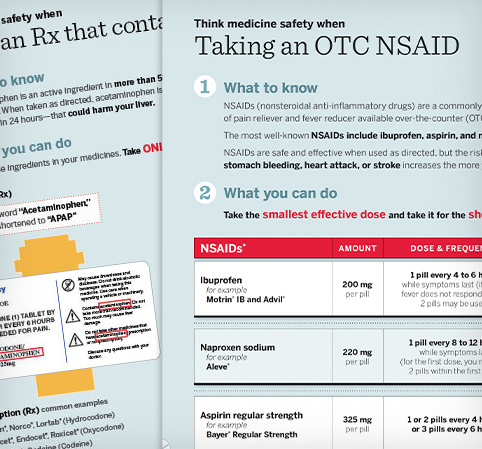Patient counseling
Nearly 60% of consumers don’t consider pre-existing medical conditions when choosing an OTC pain reliever. Even more don’t consider the other OTCs they take. However, 97% of consumers feel confident they’re making the right choice.1
Nearly 60% of consumers don’t consider pre-existing medical conditions when choosing an OTC pain reliever. Even more don’t consider the other OTCs they take. However, 97% of consumers feel confident they’re making the right choice.1
The consequences of inappropriate OTC analgesic use can be serious. Below, learn about different ways patients may accidentally misuse pain relievers, and explore counseling tips that may help prevent misuse.
Ways your patients could accidentally misuse OTC analgesics
-
Rely on past behaviors or recommendations when selecting current treatments
-
Do not know the active ingredients in their medicine
-
Take more than one product with the same ingredient concomitantly
-
Take more than recommended dose when pain levels are high, in hopes of achieving faster or stronger relief
-
Misunderstand dosing instructions
-
Take next dose too soon
-
Take an inappropriate OTC analgesic without considering their current age, coexisting medical conditions, and/or medications
Your approach to discussing OTC pain relievers can have a positive impact on how your patients choose and use them. Here are some tips for making the impact you desire.
10 tips for effective OTC analgesic counseling conversations
-
Explain WHY you’ve recommended a specific OTC pain reliever, based on your patient’s health conditions, medications, or other factors.
-
Discuss your OTC recommendations as formally and seriously as you do prescriptions. Write down the active ingredients and brand name to ensure patients choose the recommended analgesic.
-
Advise patients to look for the correct pill strength or formulation to ensure they can properly take the dose you recommend. Remind them that if they have questions when purchasing, they can consult the store pharmacist.
-
Ask patients to repeat back your recommendation and instructions, so you’re sure they understand them.
-
Acknowledge questions, even if seemingly unrelated to the condition or treatment, and shift the focus to the most relevant information.2
-
Elicit and address concerns about potential adverse effects, including ways to manage them.3
-
Make the regimen as convenient and easy to follow as possible. For example, try to provide the number of pills along with their milligram amount.3
-
If providing a different recommendation than in the past (eg, dose or analgesic type), thoroughly explain WHY, in order to supersede the previous information provided to the patient.2
-
Use visual aids such as pictures and diagrams to help clarify and reinforce comprehension of key points.4
-
Provide patient education materials to reinforce your OTC analgesic recommendation and serve as a reference for your patients at home. Download patient resources
For tips on how to communicate effectively with your patient population of older adults, download free white papers from the Gerontological Society of America.
Complimentary patient handouts
Concise, visual resources that reinforce your counseling.
References: 1. U.S. Pain Foundation. One in five Americans do not consider any key safety factors when choosing over-the-counter pain relievers [press release]. Fort Washington, Pa: PRNewswire/USNewswire. August 29, 2016. 2. Gerontological Society of America. OTC medication behaviors of older adults. Presented at GSA Annual Scientific Meeting; November 20-24, 2013; New Orleans, LA. https://www.geron.org/images/gsa/otc/OTCsymposiumnov13.pdf. Accessed July 13, 2017. 3. Gerontological Society of America. Communicating with Older Adults: Recognizing Hidden Traps in Health Care Decision Making. Washington, DC: GSA; 2016. 4. Gerontological Society of America. Communicating with Older Adults: An Evidence-Based Review of What Really Works. Washington, DC: GSA; 2012.


